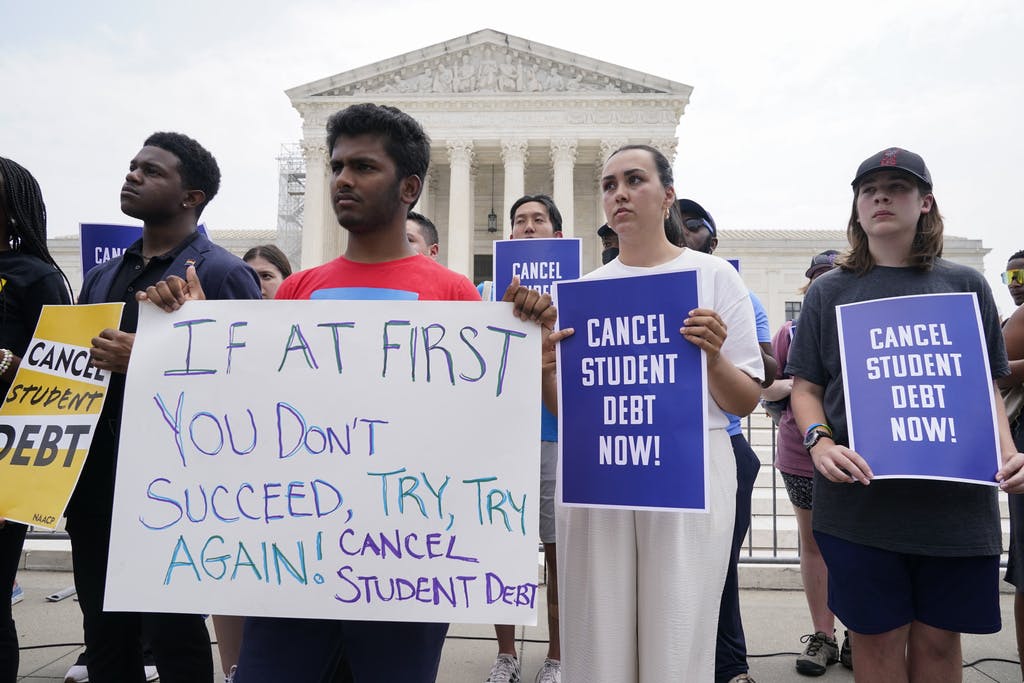Supreme Court Ruling Brings Student Debt Back to the Forefront of Political Issues
As President Biden moves forward with a new student debt forgiveness plan, congressional Republicans work to present a plan of their own.

Despite the Supreme Court’s decision to strike down President Biden’s student loan forgiveness, Democratic and liberal activist groups are seeking to make the issue a priority ahead of 2024 even as Republicans push their own plan.
A student debt forgiveness lobbying group, Protect Borrowers Action, released a commercial Thursday titled “They Said,” criticizing the Supreme Court and targeting 13 GOP representatives in vulnerable districts who have opposed student debt forgiveness.
“The Supreme Court was like, ‘Sorry bro,’ siding with right-wing interests that want to keep us in debt,” the commercial says. “They act like we aren’t listening or don’t care, but the joke’s on them.”
The group of GOP representatives targeted by the group include Congresswoman Lauren Boebert of Colorado and Congressman Mike Lawler, who defeated the Democratic Congressional Campaign Committee chairman, Sean Maloney, in 2022.
The group has invested $2 million in a campaign to influence these congressional races. Protect Borrowers Action, though, isn’t the only group fighting to raise the profile of student debt relief as an issue ahead of 2024.
A larger debt-holder advocacy organization, the Debt Collective, is also amping up its pressure around the issue and will be holding training sessions to organize a national student debt strike ahead of when payments are supposed to resume at the end of August.
Mr. Biden himself has announced that his administration will also be moving forward with another strategy to “provide student debt relief to as many borrowers as possible as quickly as possible.”
“We will ground this new approach in a different law than my original plan, the so-called Higher Education Act, that will allow Secretary Cardona … to compromise, waive or release loans under certain circumstances,” Mr. Biden said in a statement Friday.
Likewise, some congressional Republicans have begun to organize around a plan to address student debt in the form of the Federal Assistance to Initiate Repayment Act.
The bill is being pushed by Senators Cassidy and Blackburn, and it’s aimed at reducing the burden of student loan payments based on an income-driven repayment option, putting a monthly payment cap at 10 percent of a borrower’s income.
For those making less than three times the federal poverty line, or about $46,000 a year, it would also pause the accrual of interest and put half of a borrower’s payment toward the principal of a loan.
In a joint statement, three House Republicans, Burgess Owens, Lisa McClain, and Virginia Foxx, hailed the plan as a “fiscally responsible, targeted response.”
“This Republican solution takes important steps to fix the broken student loan system, provide borrowers with clear guidance on repayment, and protect taxpayers,” the representatives said.
The renewed positioning around student loan forgiveness in both the Democratic and Republican parties likely reflects that student loan forgiveness appears to have some support, even among younger Republicans.
An Economist and YouGov poll of 1,500 Americans from shortly after Mr. Biden announced his student loan forgiveness plan nearly a year ago found that 51 percent of respondents supported forgiving $10,000 in student loans while 40 percent opposed it. Another 9 percent said they were unsure.
A Data For Progress poll of 3,987 likely voters conducted ahead of the Supreme Court ruling and released Wednesday found that student loan forgiveness had become more popular over the past year.
The survey found that 54 percent of all voters supported providing debt forgiveness with a legal grounding in the Higher Education Act, including 50 percent of Republicans under 45 years old.
Republicans 45 and older were the group most opposed to student loan forgiveness, with 72 percent against debt forgiveness.
The Department of Education estimated that about 21 percent of those who would have received debt forgiveness under the previous plan are less than 25 years old, 44 percent are between 26 and 39, and the remaining 35 percent are more than 40 years old.

